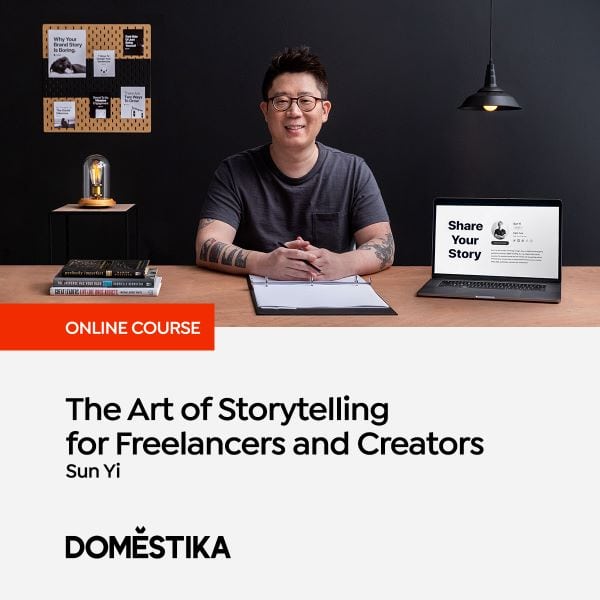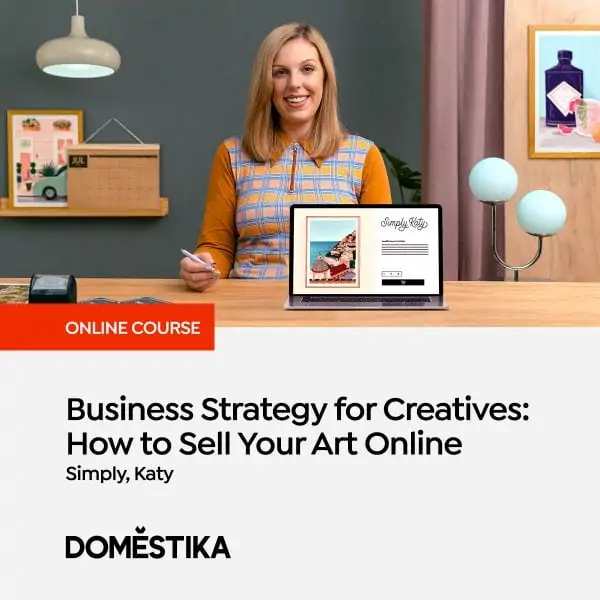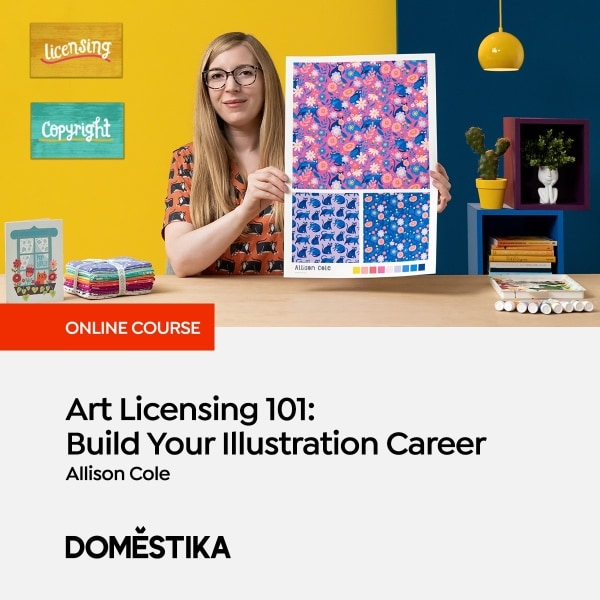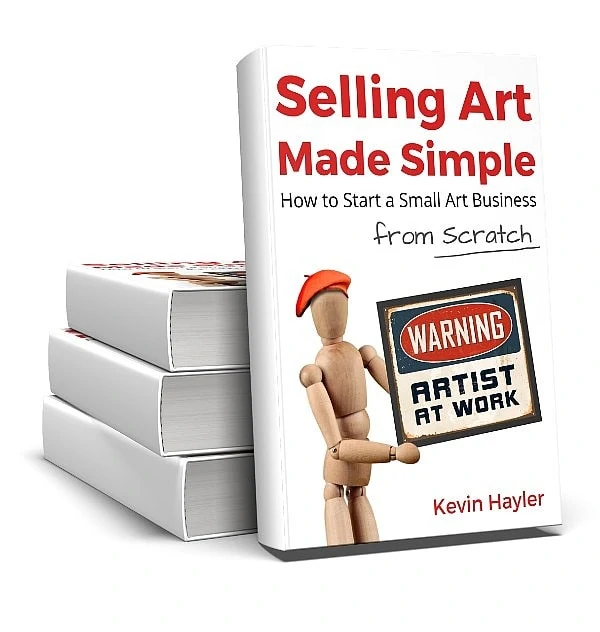Kevin Hayler: Professional Wildlife artist, author, and traveler.
I’ve been selling my art prints full-time from a market stall for over 20 years and in that time I’ve learned how to sell my art face-to-face effectively and increase sales. These 10 selling tips will teach you how to sell more art in a real-world way.
Good communication is at the heart of successful selling and it’s vital to get your message across in the simplest way possible.
Be engaging and make an extra effort and you will succeed. If you are friendly, people will enjoy your company and want to show their appreciation with a purchase.
So how do you break down the barriers with strangers?
Let’s go over the most important selling skills every artist must put into practice.
Disclaimer: When you buy something via my affiliate links I earn from qualifying purchases and sometimes earn a commission, at no extra cost to you. I am an Amazon Associate among others. I only recommend trusted sites.
1. Tell a Good Story and Sell Yourself
In my experience, too many artists fall into one of two camps, those who undervalue themselves, and those who overvalue themselves.
Sell your Story. Make it Short and make it Snappy.
Both personality types find it hard to tell a good story. It’s very hard to sell yourself if all along you are wondering why anyone would want to buy your art, and similarly, no one wants to listen to a bragging big-head.
As in most things in life, there’s a middle ground. Not too self-effacing and not too conceited
Practice makes perfect when it comes to storytelling, and never more so than in a sales context. In time, your tales will self-edit, your timing will improve, and your punch lines will deliver.
The most effective stories are honed down to the bare minimum.
Don’t just take my word for it, Sun Yi will tell you much the same on Domestika If you want to follow a class to get it right, check him out. The courses are very reasonable.
Think of your favorite anecdote, the one that’s been retold many times. It’s been tweaked and refined to the point where the storytelling is almost theater. That’s your aim with customers.
Grabbing and keeping the public’s attention is the key. There are so many distractions these days that you MUST deliver a concise and confident performance. If that damn cell phone goes off, you’ve lost them.
Be in no doubt that your purpose is not just to inform, it’s also to entertain, and in so doing you build trust.
People buy off people they like. It’s that simple.
Write Your Bio
Do you know your own story? Have you written a short bio? If not, you should.
You’ll need a good Bio for:
- Your own website and online store
- Online art galleries and marketplaces
- Traditional galleries and Exhibitions
- Art shows and art fairs
- Print-on-demand websites
- Social media channels
In fact, it’s hard to think of a situation where you don’t require a bio. You need one wherever you promote yourself. It’s not an optional extra, certainly not for a professional artist.
If you struggle try looking back and thinking about why you became an artist. You’re looking for your motivation or mission. Was there a turning point that set you on your art career?
This is all in hindsight and it doesn’t matter that you had no idea what you were doing at the time. Figure out what was happening in retrospect.
Keep your Bio insanely brief. No one wants a life story. Sum it up in a few short paragraphs, 150 words or less.
You can structure your Bio something like this:
- Your Journey Begins (The Adventure)
- Overcoming the Obstacles (Your Battles)
- The Turning Point (Your Epiphany)
- Successful Outcome (Victory)
You get the idea. Frame your story as a journey. This is what makes you interesting to your potential customer. Your aim is to be relatable and intriguing.
Don’t pretend to be something you’re not, but at the same time don’t include too much. Edit your story to the bare bones. No one wants to know the whole truth.
Read this for more help: Write an Artist About Me Page: A Great Bio in 4 Easy Steps
Check out this video. It’s full of useful tips.
2. Create Scarcity to Increase Your Art Sales
You’ve probably read about using a shortage to create a sense of urgency, It’s a classic sales ploy, and it works for selling art.
If you think about it, original works of art have scarcity built in, they’re unique, but how do you infer a limited supply of art prints?
There are different ways. When you’re selling at an art fair, or market, it’s in your interest to exploit the fear of missing out.
Try these selling tactics:
- Limiting the supply available on the day
- Selling limited edition prints (built-in shortage)
- Make a now-or-never offer (discount)
- Blame the weather! (I’m serious, this works)
You’ll need to employ these methods if you want to increase your art sales.
You must capitalize on impulse and urgency to sell more art prints from a market booth
Let’s look at these sales tactics.
Limit Your Supply of Prints
Contrived shortages WORK. Let me give an example
I stock the maximum number of prints I am likely to sell on any given day. I know how many prints I usually sell, but the customer doesn’t.
Let’s say, for argument’s sake, that I stock 5 prints of one of my drawings.
I can tell my potential customer, admiring my print, that I only have 5 remaining. It’s a true statement, and the shortage is implied. I’m not going to reveal that I rarely sell 5 in one day.
That would be crazy right?
I’m attempting to seed uncertainty. My customer should be wondering if they can risk walking away without losing their chance.
I can assess their reaction and force a decision.
I can casually suggest a small discount if they want to take it now, but it has to be delivered naturally. No pressure or they’ll recoil. Your offer is only a helping hand, if a customer senses desperation you’ve lost it. Timing and tone of voice are crucial, and that takes practice.
Offer Limited Edition Prints
The whole point of a limited edition print is scarcity. It’s the only reason you can ask for a premium. As long as your offer is genuine of course. Sadly too many artists and companies misuse the term.
This will clarify things: What Are Limited Edition Prints? 12 Things You’ve Got to Know
There will be some buyers who request a certificate of authenticity and it’s up to you if you provide one. I don’t, because my limited editions are not very expensive. It’s a personal choice.
How Many Prints Should You Offer?
The size of your edition is calculated guesswork. I began with editions of 950 and that was too high. I limited subsequent editions to 350 and that feels about right for the audience I serve.
There’s only one drawback to selling limited edition prints. Your bestsellers can sell out quickly, and your income disappears when the edition ends.
You’ll find yourself pressured to find another popular image to replace your drop in earnings.
That’s not easy, and it’s the reason why some artists and companies fool the public with ‘gold’ editions and so-called ‘artist proofs’ to make more money.
I take another course. I see why the image was so popular and draw something similar. I will reuse compositions and themes to increase the likelihood that they’ll resonate.
Get to Grips with your Art business with Katy on Domestika
The Sales Ultimatum
It’s now or never and it goes something like this:
- Invite the customer to browse
- Chat and find some common ground
- Create some uncertainty
- Make a now or never offer
- Make the sale
If only it was that simple. It is, however, the framework.
The strategy works when your customer wants your item but has doubts about parting with their hard-earned money. We’ve all been there.
The natural response for most people is to walk away and think about it.
Be warned, very few people return, because:
- They get distracted
- Buy something elsewhere
- Forget all about you
- Can’t find you again
- Change their minds
You can’t afford to let them go without making them an offer. The idea is to tip the balance in your favor. Each encounter will vary and you must judge situations as they occur.
I like to frame my offers by asking if the price puts them off. If so I ask them if they would be interested in a better deal. If not, they were never going to buy anyway.
Learn to haggle: How to Negotiate the Price of Your Art Prints and Make Money
It’s the potential art buyer who wants your art but has to justify it to themself, that matters most.
You can discount the price, but you can also flip the situation. I often ask art buyers to make me an offer.
They’re reluctant because they’re afraid to offend me. I know this.
I reassure them by asking them what they’re comfortable paying. I know from experience that people will automatically suggest 75% of the asking price, and as soon as they make me the offer they’re socially obliged to fulfill it.
I don’t make a counteroffer. Firstly, because that’s still a handsome profit, and secondly they can reject my second offer and legitimately decline the deal.
When I sell a limited edition print for £20, my printing costs are £1.00. Accepting 75% means I’m guaranteed £14 in profit.
A bird in the hand is worth two in the bush.
Blame The Weather
OK, maybe this is a British thing, we have changeable weather, and we can use that uncertainty to our advantage, that’s if we trade outdoors.
We know that people don’t like to commit themselves to a final decision. We all procrastinate.
As the seller, you’ll hear the same things said time and time again:
- Are you here all day?
- What time do you close?
- I’ve got to come back this way
- Do you have a website?
- I’ll come back after lunch
That’s when I drop the weather forecast bombshell and reveal my intention to pack up if it rains. In reality, I only pack up if it’s a torrential downpour. but that’s beside the point. I want to create urgency.
I want to force a decision. If my prospect walks away and accepts the risk they weren’t serious, and now I know at least
The weather is one of my ace cards. Here in the UK, it’s almost never perfect weather, It’s either too wet, windy, or baking hot. And I mention how it might force me to quit and go home without shame.
There is only one minor hiccup. You have to be reliable to instill trust. Threatening to close without notice is not going to work for people who might return, and a very small percentage do actually come back. What to do?
I solve that inherent contradiction by handing over a flyer or a business card, but only when all else fails. This is their guarantee.
3. Stay on Point With Your Sales Chat
Straying off-topic is a sales killer. Your sole purpose for having your work on display is to attract potential buyers. When you have their attention you must focus on the job at hand.
That’s not by being pushy, it’s about guiding your conversation back to your artwork.
One way to lose your customer is to ramble on about nothing. Chit-chat fillers should be brief and used only to break the ice or segue into something more interesting. That’s basic.
I find the problem with staying on point occurs when you are engaged with a delightful customer. I’ve lost so many sales over the years because I became so engrossed in what my ‘customer’ had to say that I forgot to sell them anything.
I’m constantly having to remind myself to turn the conversation back around to the sale. I get to a point where I suddenly realize that we’ve strayed too far and I’ve lost the thread. It can be very hard to backtrack.
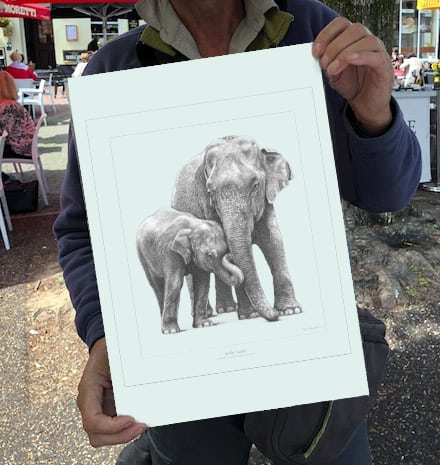
My heart sinks when I hear those departing WORDS OF DOOM…
“It’s been nice to meet you“
Not only are you sad to end an interesting chat, but you didn’t even sell a fridge magnet!
If I’m conscious of what’s happening, I can steer things back to my artwork before it’s too late. I can always return to our interesting chat later – THAT’S AFTER THE SALE.
4. Use Simple Language, not Jargon
Let’s cut to the chase, no one likes a smart alec. Keep those syllables down to a minimum. Fancy talk gets you nowhere. Assume that everyone has only a working knowledge of English until they prove otherwise.
If you let slip a clever-sounding word, you may alienate your customer. If they don’t know what the word means, that’s bad communication. Long words and jargon intimidate people.
I remember upsetting a customer many years ago when I worked in a tree nursery. I knew and described most of the trees by their Latin names and he stopped me short and complained that he didn’t know what the hell I was talking about. Of course not, I was speaking as a nurseryman and not as a customer. I lost that sale.
That was a lesson well learned.
Perhaps the equivalent mistake for an artist is being too Arty-Farty. No one wants to hear about anyone’s inner battle for self-discovery, expressed through their art. Yuk. Believe me, the public will run a mile.
There is nothing wrong with having some symbolism and metaphors hidden away but be very careful how you describe them and to whom.
The public appreciates and understands straightforward craft-based realism. They buy pictures that speak to them. What they don’t buy is the artist’s ego.

5. Good Manners Mean More Sales
It’s nothing more than the respect you show for others. Good manners cost nothing, but bad manners can cost you money.
There is no excuse for not being courteous, polite, and aware of the needs of people around you.
Take heed of these 5 things:
- If you see someone hovering around, acknowledge them.
- If you have a queue apologize for keeping anyone waiting.
- Hold your tongue if someone irritates
- When you complete a sale, shake hands
- Say please and thank you.
Social graces are important. I don’t like to eat in front of customers. I NEVER have alcohol at work, I even take care not to serve with my left hand if someone is from Asia.
Good selling skills are good social skills
It should go without saying that swearing is a NO-NO. Profanity is very unprofessional and makes you appear less trustworthy.
6. Be Fluent and Speak Clearly
When you tell a story or crack a joke you can’t stutter on the punchline, it falls flat. To be effective the delivery has to be spot-on.
Effective communication requires a confident and self-assured use of language and for those of us without a natural gift of the gab, we have to develop a store of ready-to-use stock phrases and quips to join everything up.
I like to think of it as ‘Contrived Spontaneity’
You must eliminate Ums, Ahs, and Hmms. Likewise, banish repetitive crutch words such as, ‘like’, ‘you know’, and ‘right’. These habitual verbal ticks will distract the listener and diminish your credibility.
Get a friend to tell you if you have any nervous habits, you may not have even noticed them.
If you do tend to use filler words and sounds, try to replace them with reflective pauses instead. You’re not giving a speech, so long pauses for dramatic effect will backfire. I’m talking about micro-pauses that break your sentences into bite-size chunks.
A few ‘Ums’ are OK but not when they are sprinkled throughout a sentence. You’ll bore people to death.
Speak in small bursts and not in monologs. Vary your intonations, emphasize certain words and phrases, and animate yourself with gestures.
Don’t talk over anyone and never EVER contradict anyone.
No two encounters are quite the same, so a degree of flexibility is called for if you are to remain composed and unflustered in front of the public. You will learn to adjust your manner and adapt to every client’s personality.
The trick is to gently mirror your client’s behavior. Don’t mimic anyone, but adjust to their ways.

7. Listen to Your Customers and Acknowledge Them
A good salesperson knows when to shut up. If someone is talking, listen to what they have to say. If they have a question, answer it directly and allow them to interject.
Listening is respectful. Give the customer your full attention and make eye contact. Whatever you do, don’t make it obvious that your mind is elsewhere. Don’t look around as they talk to you. Don’t fidget or God forbid look at your phone.
If my phone starts to ring, I ignore it. The person I am with has priority. I can ring back later.
If I need to interrupt, I do so in a way that doesn’t offend. I will touch a forearm and say something like,
‘Sorry, can I interrupt you just for a second?’
I’ll deal with the distraction and quickly return,
‘Sorry about that. Where were we?’
I listen and wait for nuggets of information. You never know what people will say. Of course. I’m looking for common ground and naturally, I’m hoping it will lead to a sales opportunity.

A good listener will quickly establish a rapport with their customer. There are a lot of windbags out there and very few listeners. It’s a rare treat.
On that point, there’s one drawback to being a good listener and that’s getting trapped by someone who doesn’t stop yapping.
People who talk ‘at’ you and have no social awareness are not going to buy anything. After years of trading, the alarm bells start ringing when certain ‘types’ turn up. They will kill your sales. In such cases, you MUST take action.
I will always try the polite way first by rounding off the ‘chat’ like this:
- ‘Anyway, I can’t chat all day’
- ‘I’d better crack-on, I’ve got work to do’
- ‘Good to chat but I’ve got to break off’
Most of us know the rules, some, however, will carry on regardless or even wait around! There have been times when I have feined needing a washroom to escape! How sad is that?
If all else fails, the most effective way of ending the conversation dead, try and sell them something! They’ll be gone in a cloud of dust.
8. Ask Your Customers Open-Ended Questions
If the art of conversation is to listen, the best way to get things going is to ask questions.
Given the chance, we all love talking about ourselves (Harvard Research), so ideally, you should facilitate that with a few open-ended questions.
Try to avoid questions that require only a static ‘yes’ or ‘no’ answer, they will wither on the vine.
This is a sales situation so the browsing public may be alert to your intentions and be on their guard. That, however, is no reason for not trying. The real point is to break the ice even if the conversation doesn’t flow straight away.
Examples of classic open-ended questions start with “why,” “how” or “what” but they are not easy questions to ask out of the blue. It’s a good idea to ask a closed-ended question first, and follow it up with an open one afterward.
This is a question I often ask and I have a neat reply for both outcomes:
Closed question – “Do you draw or paint?”
Answer – “Yes a little”
Open Question – “Really? What do you like doing?”
Or
Closed question – “Do you draw or paint?”
Answer – “No not me”
Open Question – “No? What do you like doing?”
The idea is to open a conversation and dig a bit deeper. It’s less about the facts and more about the feelings. A good conversation explores the emotions of doing something.
With luck, you will find common ground, and a meaningful exchange occurs quickly. Remember in a sales situation time is not on your side, so get stuck in.
9. Know Everything About Your Product
There is nothing worse than speaking to a sales assistant who knows nothing about the product. That goes for artists too. You must know everything about your own business. Let’s call it customer service.
If a customer wants to know the pressed weight of your paper, you must know the answer. If they ask you the size of frame they need, have it to hand.
I’ve even had people ask what font I’ve used on my prints. Some people actually care. (I use the Medici font by the way.)
Nothing screams incompetence like a lack of knowledge.
You should know the following things:
- How the prints are made
- The paper stock you use
- The best ways to frame your artwork
- All the dimensions for framing
- All the materials used to create your original artwork
- All prices and availability
- The backstory for each picture
- How to carry them home and after-care
Customers want to know if the printing inks are lightfast. Will the paper go yellow? Will the surface smudge? Yes, some people think a print might smudge too.
Some artists want to know your drawing techniques and what pencils you use. So tell them. I don’t hide anything, what for?
I have a wildlife theme. It’s my subject. Because I’m interested I know more than the average non-biologist passing by. I can be informative about wildlife viewing, traveling, and conservation, and that all adds to my authenticity and authority.
There is only one question that’s strictly taboo, and that’s ‘How much money do you make?’
Be patient and treat every question as if it’s the first time you’ve ever been asked. That’s a selling skill that’s hard to master, but you’ve got to try.
10. Be Upbeat, Positive, and Cheerful
Are You a Tigger or an Eeyore?
Nothing is more attractive than a person with a passion. If you have an understanding of a subject it’s easy to enthuse about it, and excitement is contagious.
Have you ever met someone so engrossed in their favorite topic that you’ve become fascinated yourself?
You must present a positive spin, it’s the easiest way to win people over. Even the subject matter must be upbeat, to some extent.
Smile and look content. Even if sales are low and you’re wondering why you bother, you must remain approachable to new customers. Don’t sulk.
We ALL have bad days and it can be hard to stop a downward spiral of despair, but you must tell yourself that some days are just dead, and there’s nothing you can do about it.
Experience teaches you that there’s always tomorrow. Bad days are part of life, they come and go. When you have a good day, the world is a great place and life is easy. It’s like a drug, you remember it and boy do you want it again.
I remember my first-day selling prints, I earned over £300. That was a long time ago, and at the time I’d never earned more than £200 in a week. After that I was like a fisherman, always waiting for the big fish to bite.
My more popular prints are positive too. They are mostly mothers and baby animals. That’s not to say everything I do is cute by any means, but on the whole, the most saleable images are predictable.
I have a few drawings that don’t sell well and that’s because they project negative feelings. Some I drew because I wanted to do them anyway, and others I assumed would do well but made a mistake.
If you make wildlife art this is gold: 12 Wildlife Art Bestsellers (Use These Subjects to Make Money)
My orphaned elephant falls into that category. I thought it was charming to draw a baby elephant feeding from a bottle. I didn’t realize that many people would find it too sad.
I’ve learned to counter the negativity. I emphasize how the Sheldrick Wildlife Trust releases all their rescued elephants back into the wild in an attempt to put a more positive spin on the story.

The same goes for the great apes. Some people see their faces as sad too for wall art. It doesn’t seem to matter that nature gives them naturally melancholy expressions, I’ve had to change my drawings subtly to compensate.
It’s not necessary to adopt the fluffy bunny approach but young animals are very appealing and they do make people smile. That’s a positive emotion and I do enjoy seeing the kid’s faces light up.
So what if you’re not in the mood?
In truth, I’m not upbeat by nature. I’m reflective and prone to introspection, very much an Eeyore. That’s no good for selling anything so I have a sales persona more akin to Tigger. I can pretend to be happier than I feel.
We all need a boost now and then: How to Motivate Yourself to Make Art: 11 Kickass Ways to Get Going
I can be cheerful, jokey, and positive, especially when I get on a roll and start selling. It’s amazing how your mood changes as soon as you get a few sales under your belt.
And there’s nothing more satisfying than selling your own artwork. It’s a special feeling knowing that someone has just bought your art to put on their wall. It’s not just about the money, it validates all your efforts and hard work.
How to Sell More Art: Final Thoughts
This is the kind of post I wish I’d read before I started to trade. We are led to believe that the art world is all about exhibitions and gallery representation, when in fact, when you boil it down to the basics, it’s just another form of retail. We over-complicate things.
Art collectors are the exception, not the rule. The public, on the whole, buy pictures as home decor. That doesn’t diminish the work. Different people want different things for reasons that are personal to themselves.
It’s your job to serve your customers with what they want, in a way that pleases you to do it. It’s a compromise, much like anything else in life. Why should art be any different?
Most successful artists know how to monetize their artwork in multiple ways. They don’t confine themselves to one gallery or outlet, they diversify and have different income streams.
I’ve been selling my prints from a market stall for many years, but I also sell online to reach a wider audience. You can reach new customers and markets by adapting your images to suit other platforms.
You’re not confined to having your own online shop, although I advise you to have one, you can use an online marketplace like Etsy with a built-in global audience. Try Saatchi Art to sell your original paintings and Redbubble for selling your designs on merchandise.
You can find your perfect audience on the web for any type of art. Don’t be put off by the ‘fine art’ label. There is room for everyone.
Consider these:
- Online Galleries
- Art Licensing
- Digital Downloads
If you need some help with licensing and what it’s all about, this is a popular course by Alison Cole on Domestika
Personally, I’ve always sold the bulk of my art prints, and original artworks, by selling in person, using my online presence to boost my sales as a profitable side-line.
Here’s the good news, it’s nothing that can’t be learned.
Your confidence increases as you start to make sales. You haven’t got to be wildly go-getting and dynamic, I’m certainly not, but you must be determined to put in the hard work and not give up.
The only way to really learn is on the job and if you can learn from your mistakes, and not be beaten by them, you have every chance of making your art business succeed.
If you like the way I draw and want to try things for yourself, this is my basic kit
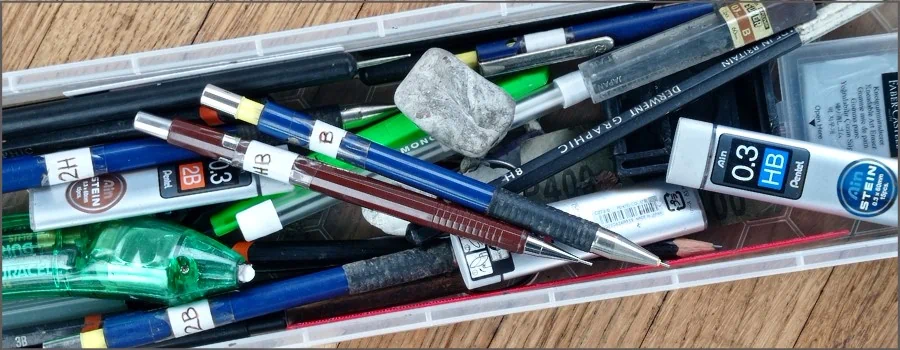
If you want an alternative to Amazon, check out art supplies or BLICK
If you are serious about selling more art you can’t afford to miss this guide. It’s everything you need to start a business!
Check out these other articles, I think you’ll like them:
- 25 Platforms for Artists to Sell Their Art Online and Make Money
- What Kind of Art Sells Best? All The Secrets Revealed
- Do Artists Need a Website? Yes – 11 Best Reasons Why
- How to Sell Art on The Street: By a Street Artist
- Is Your Art Good Enough to Sell? You Need to Know This…
- How to Sell Art Prints on Etsy: Mega Selling Guide
- How to Make Prints of Your Art – Printing Art Explained in Detail
- What Size Art Sells Best? Frames and Apertures – FREE Chart
- How to Sell Your Drawings (All You Need to Know)
- How To Sell Landscape Paintings: 13 Ways to Make More Money
- Can You Copy Art and Sell a Painting of a Painting? I Found Out
Plus find an ONLINE COURSE that suits you.
PIN IT AND SAVE IT
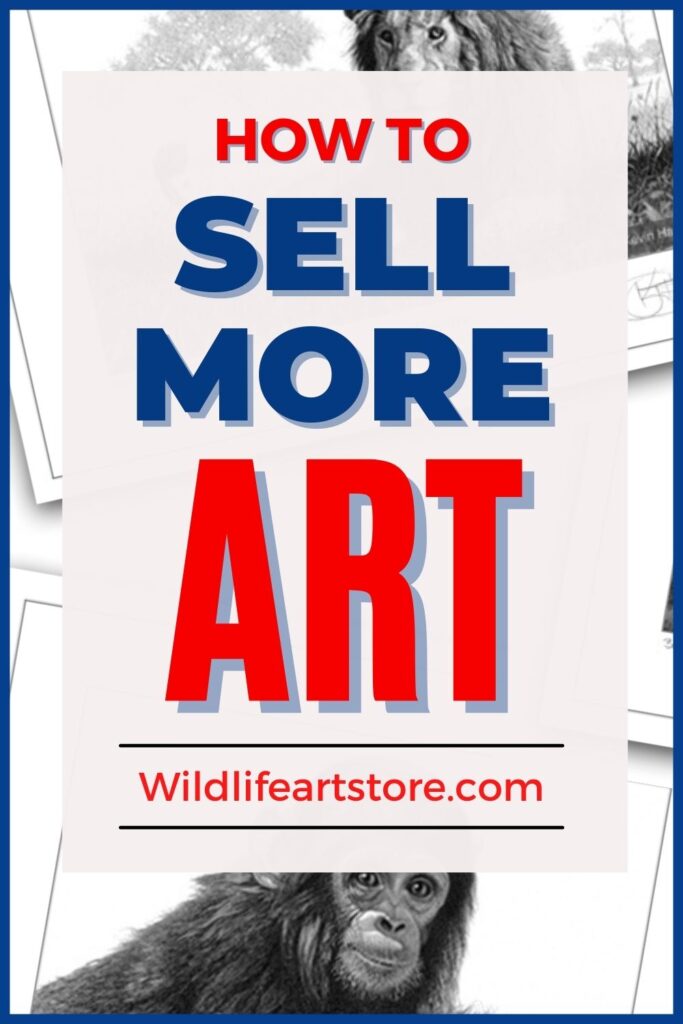

Hi, I’m Kevin Hayler
I’ve been selling my wildlife art and traveling the world for over 20 years, and if that sounds too good to be true, I’ve done it all without social media, art school, or galleries!
I can show you how to do it. You’ll find a wealth of info on my site, about selling art, drawing tips, lifestyle, reviews, travel, my portfolio, and more. Enjoy


